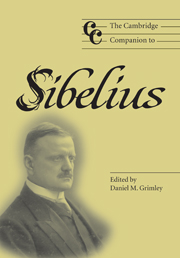Book contents
- Frontmatter
- Introduction
- Part I Forging a voice: perspectives on Sibelius's biography
- Part II Musical works
- Part III Influence and reception
- Part IV Interpreting Sibelius
- 14 Different kinds of fidelity: interpreting Sibelius on record
- 15 Performing Sibelius
- Notes
- Select bibliography
- Index of names and works
15 - Performing Sibelius
from Part IV - Interpreting Sibelius
Published online by Cambridge University Press: 28 September 2011
- Frontmatter
- Introduction
- Part I Forging a voice: perspectives on Sibelius's biography
- Part II Musical works
- Part III Influence and reception
- Part IV Interpreting Sibelius
- 14 Different kinds of fidelity: interpreting Sibelius on record
- 15 Performing Sibelius
- Notes
- Select bibliography
- Index of names and works
Summary
Though Sibelius conducted the premieres of the vast majority of his major symphonic works himself, he committed none of them to record. As Bethany Lowe points out in the preceding chapter, unlike with Elgar, we do not have a recorded legacy of Sibelius's interpretative view of his own music. During his lifetime, however, Sibelius enjoyed the support of a wide range of leading interpreters, from Robert Kajanus in Finland, to Sir Thomas Beecham in England and Herbert von Karajan in Germany, many of whom committed their work to recording on gramophone. The contrast with the relative lack of international interest in music of Sibelius's Danish contemporary, Carl Nielsen, is both striking and significant: the recorded reception history of the two great Nordic composers could hardly be more different. Even during the period, following his death, when Sibelius's music seems to have occupied a less prominent place in the concert repertory, new recordings of his work continued to appear, and recent years have witnessed a remarkable number of new interpretations issued on compact disc.
The relationship between performance and academic criticism has sometimes seemed rather a distant and ambivalent one. The final chapter is an attempt to bridge the divide and find common ground, by examining aspects of Sibelius interpretation from the perspectives of two authoritative interpreters of his work, Sir Colin Davis and Osmo Vänskä. The two conductors were chosen not simply for their pre-eminence, but also because their work is the product of very different interpretative contexts. Davis's performances are among the most powerful and original in the Anglo-American Sibelius tradition, while Vänskä leads a younger generation of Finnish interpreters.
- Type
- Chapter
- Information
- The Cambridge Companion to Sibelius , pp. 229 - 242Publisher: Cambridge University PressPrint publication year: 2004

